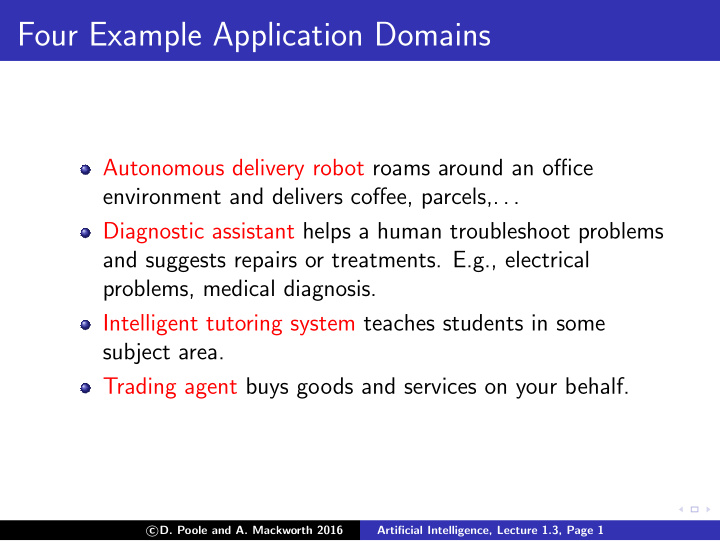



Four Example Application Domains Autonomous delivery robot roams around an office environment and delivers coffee, parcels,. . . Diagnostic assistant helps a human troubleshoot problems and suggests repairs or treatments. E.g., electrical problems, medical diagnosis. Intelligent tutoring system teaches students in some subject area. Trading agent buys goods and services on your behalf. � D. Poole and A. Mackworth 2016 c Artificial Intelligence, Lecture 1.3, Page 1
Domain for Delivery Robot r131 r129 r127 r125 r123 r121 r119 r117 lab3 lab4 r115 lab1 lab2 r113 stairs r101 r103 r105 r107 r109 r111 � D. Poole and A. Mackworth 2016 c Artificial Intelligence, Lecture 1.3, Page 2
Autonomous Delivery Robot Example inputs: Abilities: movement, speech, pickup and place objects. Prior knowledge: its capabilities, objects it may encounter, maps. Past experience: which actions are useful and when, what objects are there, how its actions affect its position. Goals: what it needs to deliver and when, tradeoffs between acting quickly and acting safely. Observations: about its environment from cameras, sonar, sound, laser range finders, or keyboards. � D. Poole and A. Mackworth 2016 c Artificial Intelligence, Lecture 1.3, Page 3
What does the Delivery Robot need to do? Determine where Craig’s office is. Where coffee is. . . Find a path between locations. Plan how to carry out multiple tasks. Make default assumptions about where Craig is. Make tradeoffs under uncertainty: should it go near the stairs? Learn from experience. Sense the world, avoid obstacles, pickup and put down coffee. � D. Poole and A. Mackworth 2016 c Artificial Intelligence, Lecture 1.3, Page 4
Domain for Diagnostic Assistant in a Smart Home outside power cb1 w5 s1 w1 circuit breaker cb2 s2 w2 w3 off s3 w0 switch on w6 w4 two-way p2 switch l1 light p1 l2 power outlet � D. Poole and A. Mackworth 2016 c Artificial Intelligence, Lecture 1.3, Page 5
Diagnostic Assistant Example inputs: Abilities: recommends fixes, ask questions. Prior knowledge: how switches and lights work, how malfunctions manifest themselves, what information tests provide, the side effects of repairs. Past experience: the effects of repairs or treatments, the prevalence of faults or diseases. Goals: fixing the device and tradeoffs between fixing or replacing different components. Observations: symptoms of a device or patient. � D. Poole and A. Mackworth 2016 c Artificial Intelligence, Lecture 1.3, Page 6
Subtasks for the diagnostic assistant Derive the effects of faults and interventions. Search through the space of possible fault complexes. Explain its reasoning to the human who is using it. Derive possible causes for symptoms; rule out other causes. Plan courses of tests and treatments to address the problems. Reason about the uncertainties/ambiguities given symptoms. Trade off alternate courses of action. Learn what symptoms are associated with faults, the effects of treatments, and the accuracy of tests. � D. Poole and A. Mackworth 2016 c Artificial Intelligence, Lecture 1.3, Page 7
Trading Agent Trading agent interacts with an information environment to purchase goods and services. It acquires a users needs, desires and preferences. It finds what is available. It purchases goods and services that fit together to fulfill your preferences. It is difficult because users preferences and what is available can change dynamically, and some items may be useless without other items. � D. Poole and A. Mackworth 2016 c Artificial Intelligence, Lecture 1.3, Page 8
Trading Agent Inputs Abilities: acquire information, make recommendations, purchase items. Prior knowledge: the ontology of what things are available, where to purchase items, how to decompose a complex item. Past experience: how long special last, how long items take to sell out, who has good deals, what your competitors do. Goals: what the person wants, their tradeoff. Observations: what items are available, prices, number in stock, � D. Poole and A. Mackworth 2016 c Artificial Intelligence, Lecture 1.3, Page 9
Intelligent Tutoring System Abilities: Present information, give tests Prior knowledge: subject material, primitive strategies Past experience: common errors, effects of teaching strategies Goals: the students should master subject material, gain social skills, study skills, inquisitiveness, interest Observations: test results, facial expressions, questions, what the student is concentrating on � D. Poole and A. Mackworth 2016 c Artificial Intelligence, Lecture 1.3, Page 10
Common Tasks of the Domains Modeling the environment Build models of the physical environment, patient, or information environment. Evidential reasoning or perception Given observations, determine what the world is like. Action Given a model of the world and a goal, determine what should be done. Learning from past experiences Learn about the specific case and the population of cases. � D. Poole and A. Mackworth 2016 c Artificial Intelligence, Lecture 1.3, Page 11
Recommend
More recommend